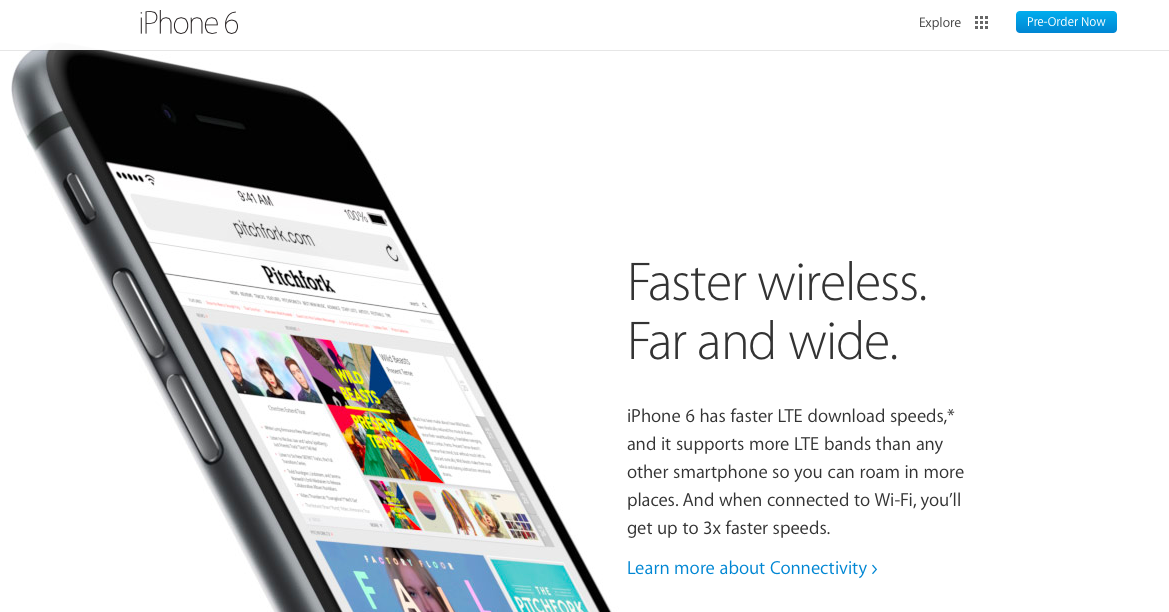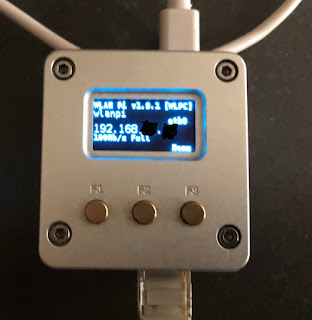What's New (and Missing) in the WiFi for iPhone 6
Two years ago tomorrow Apple introduced the iPhone 5. It was a big deal. It was a big deal for gadget folks who wanted a bigger iPhone. It was a big deal for wireless LAN folks who wanted users to use smartphones with speedier WiFi.
Now the iPhone 6 has been announced and it appears to be more of the same. Gadgeteers get their bigger iPhone. Wireless folks get their faster speeds. Problem is, the faster wireless speeds likely won't mean anything for high capacity wireless deployments.
The big news about the iPhone 6 is 802.11ac. Yippee! Apple has finally adopted the latest and greatest WiFi standard in a mobile device.
802.11ac has data rates as high as 6.9 Gbps in the standard, but wireless LAN folks know that's not what happens in real life. Real 802.11ac devices top out at a 1.3 Gbps data rate when multiple input-multiple output (MIMO) antenna systems are supported, while non-MIMO devices top out at 433 Mbps.
The iPhone 6 and iPhone 6 Plus are non-MIMO 802.11ac devices. That means a top rate of 433 Mbps. That is higher than the top rate of the 802.11n-supporting iPhone 5 and iPhone 5S, which is 150 Mbps. And that is where Apple gets thenerve justification for putting this on their site:
Think about the average high-capacity wireless network. Do the users have a line of sight to the APs? Usually, No. Are the users within thirty feet (ten meters) of the APs? Often, No. Is it better to spread users out among four or five times as many channels? Definitely, Yes. If you agree with these answers, then 802.11ac in the iPhone 6 and iPhone 6 Plus reverts to the 150 Mbps data rates used in the iPhone 5 and iPhone 5S.
A year ago, yours truly wrote that non-MIMO devices were going to be around for a while. MIMO drains battery life faster and it can cause a device to heat up. So, the lack of MIMO in the new iPhones is no surprise. But it is disappointing. And it comes down to this:
802.11n w/ MIMO > 802.11ac w/o MIMO
The iPad Air, which has been out for about a year now, is a mobile device from Apple that supports MIMO.
Now the iPhone 6 has been announced and it appears to be more of the same. Gadgeteers get their bigger iPhone. Wireless folks get their faster speeds. Problem is, the faster wireless speeds likely won't mean anything for high capacity wireless deployments.
The big news about the iPhone 6 is 802.11ac. Yippee! Apple has finally adopted the latest and greatest WiFi standard in a mobile device.
802.11ac has data rates as high as 6.9 Gbps in the standard, but wireless LAN folks know that's not what happens in real life. Real 802.11ac devices top out at a 1.3 Gbps data rate when multiple input-multiple output (MIMO) antenna systems are supported, while non-MIMO devices top out at 433 Mbps.
The iPhone 6 and iPhone 6 Plus are non-MIMO 802.11ac devices. That means a top rate of 433 Mbps. That is higher than the top rate of the 802.11n-supporting iPhone 5 and iPhone 5S, which is 150 Mbps. And that is where Apple gets the
You see, 433/150 = almost 3. That means three times faster wireless! Except it doesn't.
802.11ac is basically the same thing as 802.11n. I know that 433 and 150 seem like very different numbers, but in most real world cases, they're actually the same.
Here's how it works:
802.11n = 150 Mbps -->
--> Normal 802.11ac = 150 Mbps -->
--> 802.11ac with clear line of sight and a distance less than 30ft/10m = 200 Mbps -->
(That's because when you're that close and there are no obstructions, then 802.11ac can use a technology called 256-QAM, which allows waves to carry 8 bits of data rather than 6 bits. 8/6 = 200/150, so that means that adding 256-QAM boosts the top data rate to 200 Mbps.)
--> 802.11ac with clear line of sight and a distance less than 30ft/10m and 80 MHz channels enabled = 433 Mbps
(80 MHz channels are no good for high capacity WiFi. Instead of being able to split users up amongst 9 [if disabling dynamic frequency selection {DFS}] or 21 [if enabling DFS] channels, an 80 MHz wireless network only has 2 [non-DFS] or 4 [DFS] channels. And here in the U.S. of A., our beloved FCC regulatory commission just made it a whole lot harder to use DFS channels because of Item 67 in the 2014 updates to UNII rules.)
Think about the average high-capacity wireless network. Do the users have a line of sight to the APs? Usually, No. Are the users within thirty feet (ten meters) of the APs? Often, No. Is it better to spread users out among four or five times as many channels? Definitely, Yes. If you agree with these answers, then 802.11ac in the iPhone 6 and iPhone 6 Plus reverts to the 150 Mbps data rates used in the iPhone 5 and iPhone 5S.
A year ago, yours truly wrote that non-MIMO devices were going to be around for a while. MIMO drains battery life faster and it can cause a device to heat up. So, the lack of MIMO in the new iPhones is no surprise. But it is disappointing. And it comes down to this:
802.11n w/ MIMO > 802.11ac w/o MIMO
The iPad Air, which has been out for about a year now, is a mobile device from Apple that supports MIMO.
In a typical high capacity WiFi environment, the iPad Air or iPad Mini is going to get as high as 300 Mbps in the 5 GHz band or 144 Mbps in the 2.4 GHz band. The iPhone 6 or iPhone 6 Plus is going to get as high as 150 Mbps in 5 GHz, or 72 Mbps in 2.4 GHz. That's big. It's big for users of the gadgets and it's even bigger for the WLAN folks who have to manage those networks. Apple may have done a solid for people who want to be able to see five Tweets on their screen at a time instead of four, but for wireless folks who have to deal with high capacity networks they didn't help us out as much as they could have.
***
If you like my blog, you can support it by shopping through my Amazon link or donating Bitcoin to 1N8m1o9phSkFXpa9VUrMVHx4LJWfratseU
ben at sniffwifi dot com
Twitter: @Ben_SniffWiFi
ben at sniffwifi dot com
Twitter: @Ben_SniffWiFi



Yeah, yet another marketing post which is "technically true" but will almost never be achieved in reality. Marketing really is the bane of the WLAN.
ReplyDeleteNice post Ben. Thanks for writing (and thinking) discriminately about 11ac. You are one among a very small crowd.
ReplyDeleteMuch appreciated, MB. I thank my mom for blessing me with a sensitive B.S. detector.
DeleteThank you
ReplyDeleteGreat explanation, Ben. BTW, I just finished a course on the Ubiquiti Unifi series and they state in their course (and test on the fact) that the listed speed is approximately 2x effective speed due to wireless signalling overhead. Another thing which can bring performance down is long vs. short guard intervals in 802.11ac and n. That 150 starts looking pretty weak if there is anything between your iPhone and the AP.
ReplyDeleteI'm not sure what all above means, but.... I can tell you I have a 6+ and the speed difference in picture and file uploads to the connected storage on my router is not even comparable. What would normally take about 1-2 minutes to upload now takes about 15 seconds!! AC is all about network speed more than internet speed. If you have files and pitures on a USB drive connected to a router GET AN AC ROUTER!!! WAAAY FASTER!
ReplyDeleteI don't understand geek...
ReplyDeleteWonderful article. It helped me learn about MIMO, plus the math exposing shenanigans (Of sorts I suppose) is always appreciated. But I have a question: I have an original iPhone 6 Plus ( not refurbished or jail broken or otherwise modified). Why am I getting + or - from 290 Mb/s to 300 Mbs/s?? Am I just lucky? Did apple sneak in MIMO in subsequent fabrications? At home I have Verz FIOS with a dedicated 300Mb line. I split my wifi network into two (2.4hz & 5Hz) because modem/router is less than 18 feet from me so I could specifically choose the faster 5Hz. Unless I read this article wrong ( I prob. did ); I should not be getting 290-300 speeds on my non-mimo iPhone?
ReplyDeleteThanks !!
P.S. I don't really expect a response but I thought it would be of interest to others, like me, who don't need/want/tired of buying an "S" model iPhone every other years.
Peace, respect.
Thoughtful blog, thanks for posting.
ReplyDeleteI'm excited about Apple adopting a faster WiFi standard.
ReplyDelete956F3582EB
ReplyDeletekiralık hacker
hacker arıyorum
kiralık hacker
hacker arıyorum
belek
1F7958165A
ReplyDeletehacker bul
hacker arıyorum
tütün dünyası
hacker bulma
hacker kirala